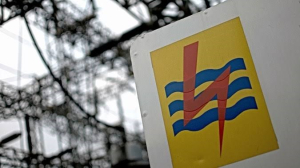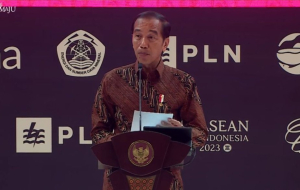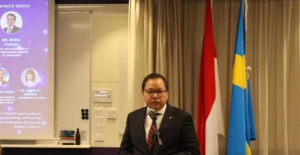IEEFA: Cut on PLTU dependence to end PLN’s, Indonesia's financial burden
State electricity company PT PLN can solve its financial problems by accelerating the development of solar and wind energy. Increased solar and wind energy capacity, as well as less coal, will cut PLN's cost of generation, which in turn will lower the country's electricity subsidy burden.
May 13, 2025 (IEEFA Asia): The government's accelerated power plant development project in 2006-2015 has fuelled massive power plant expansion in Indonesia, but has now become a financial burden to PLN and the state budget. Accelerating the development of renewable energy and phasing out coal-fired power plant (PLTU) operations could be a solution to this problem, given that subsidies and compensation to PLN have reached Rp123 trillion or US$7.6 billion by 2022.
"Subsidies and compensation to PLN have become a huge burden on the state budget, and will remain so in the coming years," Mutya Yustika, author of the Institute for Energy Economics and Financial Analysis (IEEFA) report and an IEEFA Energy Finance Analyst, said. "The gradual retirement of coal-fired power plants offers a number of benefits, such as reduced impact of coal price volatility and significantly lower maintenance costs."
Referring to the IEEFA’s latest report Pathways to Financial Sustainability for PLN through Renewable Energy Development, along with the massive growth in PLTU capacity, PLN's financial burden has also increased due to contractual obligations from the Power Purchase Agreement (PPA). In 2022, PLN's operating costs reached Rp386 trillion or US$ 24 billion, a 20 percent increase from 2021's Rp323 trillion or US$23 billion, driven by electricity payments to independent power producers (IPPs) and coal purchase costs.
PLN's coal purchase costs in 2022 were recorded at 16 percent of total operating costs. This cost increased by 49 percent in five years, from Rp42.41 trillion or US$ 2.6 billion in 2017 to Rp63.06 trillion or US$4 billion in 2022. However, the increase in costs is not followed by considerable growth in electricity generation from coal-fired power plants, signalling the potential for inefficient energy production.
According to the Ministry of Finance, the difference between the average cost of generation (BPP) and the electricity tariff will determine the amount of subsidy provided by the state. "However, considering that electricity tariff adjustments can trigger negative public sentiment, PLN needs to lower the BPP in order to reduce dependence on subsidies. The BPP includes the cost of fuel and lubricants, including the purchase of coal," Yustika said.
In addition to subsidies, the government also provides revenue compensation to PLN to cover the difference in non-subsidised tariffs that have not increased since 2017. According to the Ministry of Energy and Mineral Resources (ESDM), there are four factors that influence the adjustment of non-subsidised tariffs, namely the inflation rate, the benchmark coal price (HBA), the Indonesian Crude Price (ICP), and the rupiah exchange rate.
"PLN is still grappling with coal prices due to the rupiah and dollar exchange rates. The exposure of coal prices using the dollar to PLN requires careful management, given market dynamics and currency fluctuations," Yustika said.
As of December 2023, PLN has 20.4 gigawatts (GW) of coal-fired power plants, 23 percent of which have been operating for more than 20 years. "The gradual retirement of these old PLTUs will significantly reduce maintenance costs because the economic benefits of the plant decrease with age," she said.
Renewable energy, the solution
The transition from fossil fuels to renewable energy will also help overcome PLN's financial problems. "With the continued decline in the cost of developing renewable energy and the continued increase in the cost of operating coal-fired power plants, now is the right momentum for Indonesia to accelerate the retirement of coal-fired power plants and the development of renewable energy," Yustika said.
In the IEEFA report, Yustika revealed that Indonesia is not expected to realize its renewable energy target. This is due to PLN's false assumption that large-scale renewable energy development is expensive. In fact, advances in renewable energy technology have made energy production more efficient, capital expenditure and operation and maintenance costs lower, and infrastructure sustainable.
"Globally, the cost of renewable energy, especially solar and wind, has fallen in the last five years and become cheaper compared to fossil fuels, and the cost of solar panels is expected to continue to fall," she said.
"In Indonesia, although the Domestic Content Level (TKDN) regulation that requires the utilization of domestic products in industrial production increases the investment cost of renewable energy, the levelized cost of electricity (LCOE) of solar and wind remains competitive compared to coal and is expected to become cheaper by 2030," she added.
"Another advantage of renewable energy projects, especially solar and wind, is that they can be built much faster than fossil fuel power plants. As renewable energy becomes cheaper than coal, reducing Indonesia's dependence on coal and accelerating renewable energy development will help Indonesia meet its Paris Agreement commitments and financial targets," Yustika cited.
Indonesia has less than seven years to realize its Paris Agreement commitments and has set a target of 23 percent by 2025.
Tag
Already have an account? Sign In
-
Start reading
Freemium
-
Monthly Subscription
30% OFF$26.03
$37.19/MonthCancel anytime
This offer is open to all new subscribers!
Subscribe now -
Yearly Subscription
33% OFF$228.13
$340.5/YearCancel anytime
This offer is open to all new subscribers!
Subscribe now






